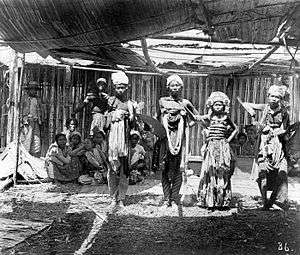Sasak people
|
Sasak lady with traditional songket weaving. | |
| Total population | |
|---|---|
| (3,600,000[1]) | |
| Regions with significant populations | |
| West Nusa Tenggara (Indonesia): 3 million | |
| Languages | |
| Sasak language, Indonesian language | |
| Religion | |
| Islam (Orthodox Waktu Lima) and Traditional syncretist (Wetu Telu), Hindu, and Animist-Buddhist[2] | |
| Related ethnic groups | |
| Balinese, Sumbawa people |
The Sasak people live mainly on the island of Lombok, Indonesia, numbering around 3.6 million (85% of Lombok's population). They are related to the Balinese in language and race, although the Sasak are predominantly Muslim while the Balinese are Hindu.
History

Little is known about Sasak history except that Lombok was placed under direct rule of the Majapahit prime Minister, patih Gajah Mada. The Sasaks were forced to convert to Islam between the late 16th century to early 17th century under the influence of Pangeran Prapen (Sunan Prapen), the son of Raden Paku (Sunan Giri)[3][4] or Sunan Giri himself and the Muslim Makassarese, frequently mixing basic Islamic beliefs with Hindu-Buddhist beliefs, thus creating the Wetu Telu religion.[5] Lombok was conquered by the Gelgel Balinese kingdom in the early 16th century,[6] thus bringing a large population of Balinese to Lombok. The Balinese population of Lombok today is about 300,000, 10–15% of Lombok's population. The Balinese have also strongly influenced the Wetu Telu religion of Lombok.[7]
Language
The Sasak language is closely related to the languages of Bali and Sumbawa, and to most other languages of Western Indonesia more distantly. There are also a number of Sasak dialect in various regions such as Kuto-Kute (North Sasak), Meno-Mene (Central Sasak), Mriak-Mriku (Central South Sasak), Ngeno-Ngene (Central East Sasak, Central West Sasak), Ngeto-Ngete (Northeast Sasak) and so on.[8]
Religion

Most of the Sasaks today are adherents of the Waktu Lima version of Islam. Waktu Lima or Five Times signifies the five daily prayers which Muslims are required to do.
The term Waktu Lima is used to distinguish them from the Sasaks who are practitioners of Wetu Telu or Three Symbols who only pray three times a day. Orthodox Islamic teachers generally instruct adherents to pray five times a day.
Large numbers of people adhering to the Wetu Telu faith can be still found throughout the island, especially in the village of Bayan, where the religion originated. Large Wetu Telu communities can be still found in Mataram, Pujung, Sengkol, Rambitan, Sade, Tetebatu, Bumbung, Sembalun, Senaru, Loyok and Pasugulan. A small minority of Sasaks called the Bodha (estimated population: 8,000) are mainly found in the village of Bentek and on the slopes of Gunung Rinjani. They are totally untouched by Islamic influence and worship animistic gods, incorporating some Hindu and Buddhist influences in their rituals and religious vocabulary. This group of Sasak, due in part to the name of their tribe, are recognized as Buddhists by the Indonesian government.
The Bodha have the same magico-religious officials and institutions as the Wetu Telu (with the exception of course of the Kiyai, the Wetu Telu religious official dealing with all aspects of the Wetu Telu religion which mixes Islam and animism). The Bodhas recognize the existence of five main gods, the highest of which is Batara Guru, followed by Batara Sakti and Batara Jeneng with their wives Idadari Sakti and Idadari Jeneng, though they also believe in spirits and ghosts. The Bodha religion is also to some extent influenced by both Hindu and Buddhist concepts. Of late, they have come under the influence of mainstream Buddhism from Buddhist missionaries.[9]
Art performances
See also
References
- ↑ "Sasak of Indonesia". PeopleGroup.org. Retrieved 2014-10-08.
- ↑ From Ancestor Worship to Monotheism–Politics of Religion in Lombok
- ↑ Martijn Theodoor Houtsma, ed. (1993). E.J. Brill's First Encyclopaedia of Islam, 1913–1936, Volume 5. BRILL. ISBN 90-04-09791-0.
- ↑ David Harnish & Anne Rasmussen (2011). Divine Inspirations: Music and Islam in Indonesia. Oxford University Press. ISBN 0-19-979309-3.
- ↑ Kaj Arhem & Guido Sprenger (2015). Animism in Southeast Asia. Routledge. ISBN 1-317-33662-3.
- ↑ Robert Cribb (2013). Historical Atlas of Indonesia. Routledge. ISBN 1-136-78057-2.
- 1 2 3 Kal Müller (1997). David Pickell, ed. East of Bali: From Lombok to Timor. Tuttle Publishing. ISBN 962-593-178-3.
- ↑ "Sasak". Ethnologue. Retrieved 2014-10-08.
- ↑ Webshots pics
- ↑ Akil Yunus (11 June 2016). "Lombok, the island that God smiles upon". Star2. Retrieved 2016-11-01.
External links
| Wikimedia Commons has media related to Sasak. |
